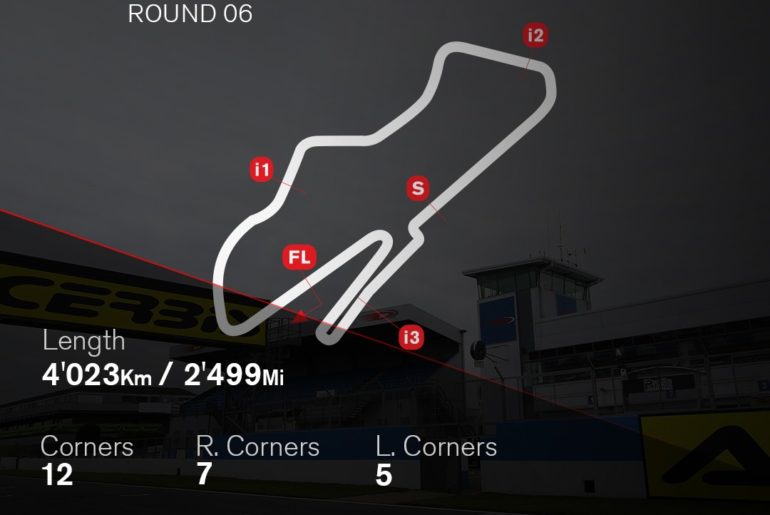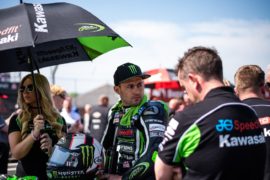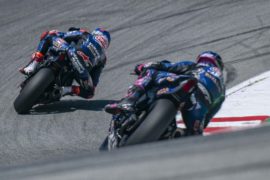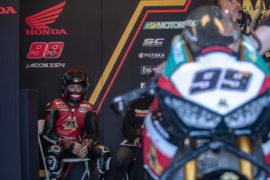Jonathan Rea was the man that ended Tom Sykes’ winning streak at Donington Park. The reigning WorldSBK champion snapped a nine-race streak for Sykes by winning Race 2 at the British round, and he’s excited ahead of his home round.
“Donington is a circuit of two halves,” said Rea. “Sector 1 and 2 are very flowing, and the final sector is very stop and start.”
“It’s very difficult to find the right setup, and you’re always making a compromise. Sometimes I have had a setting that is great for the first halfm and other times I’ve set the bike up for the final sector.”
“It really depends on what you need to do with the bike you have. You need to find a compromise between stability and agility, but it’s a very satisfying track to get right.
“This is a track where the harder you try the slower you go. You need to be calm and work with the bike. It’s very enjoyable here when you get it right.”
“I love this track, but the final sector lets down the track, to be honest. The first half is so good, but it’s almost like the designers ran out of inspiration in the final section.”
While the end of the lap isn’t to the tastes of a Superbike rider the rest of the circuit certainly is. Redgate to Coppice is immense, and every corner presents a different challenge. This is two miles of motorcycling perfection that is thrilling and technical.
“Redgate has a fifth gear entry where you’re doing around 260 km/h,” explains Rea of Turn 1. “We backshift three gears to get back into second gear, but once you exit the first corner you’re straight into Hollywood.”
“This section is where experience really counts. It’s difficult to find a reference point because it’s blind, but I’m aiming for a small kerb on the right side of the track. I try and run as close to that as I can before letting the bike drift a little bit, before the second part of the corner.”
“You always feel like you’re turning in too early, but the forces on the bike mean that everything is harder to turn because you’re in fourth gear at this point.”
“You need to understand the track, and where you need to be, because there’s a lot of crashes in this section. A lot of these come from riders rolling off the gas to find that kerb, and the rear is unloaded at the wrong time and you lose the front.”
“It’s not always true but Ron Haslam told me ‘you’ll never tuck the front if you’re on the gas’ so I do think about that through this section.”
“From Redgate to Craner is very busy, but then you’re into the Old Hairpin. It’s definitely not a hairpin though, it’s third gear and fast! This is a very important part of the lap because the exit of the Old Hairpin is crucial because you’re exit here sets your speed for the entry to McLeans.”
“It’s uphill and you need to accelerate well. It’s very easy to get sucked into the Old Hairpin, you have so much momentum down the hill from the Craner Curves, but you need to stop well and be in the correct position to accelerate well for Starkeys and Schwantz.”
“The exit of the hairpin depends a lot on your gearing – do you shortshift or try and hold a longer gear? – but the acceleration is so important.”
“The entry to Schwantz is fun, but the line can change a lot because of the grip or your speed and revs. If you’re able to release the brake early and try and roll through Schwantz before braking for McLeans, or if you have to brake harder through Schwantz. It’s very difficult but it depends on the bike settings.”
“McLeans is a strange corner because there are times where you feel fast in that corner, but you’re actually slow.”
“You need to get the bike stopped and exit as smooth as possible because we’ll try and hold the same gear from Turn 7 into Turn 8, but that can mean that the gearing is lazy on the exit of McLeans.”
“That’ll mean the bike wants to push you wide, so you need to make sure you can catch the bike and be in the right place for Coppice.”
“It’s a blind entry into Coppice, as you brake up the hill. There’s no markers that you can really use for this section, last year I used a tarmac join, but it’s a tough corner. You always feel like you can go faster through here, and the corner almost makes you go faster.”
“But it’s so hard, and you can see a lot of front end crashes here because you push too hard through the entry, and are carrying too much speed. It’s third gear through here, and you shortshift into fourth for the exit, and then it’s down the backstraight.”
While the first half of the lap is fast and flowing the second half is filled with a stop-and-go nature.
The flowing nature comes to an abrupt end with the Foggy Esses. This chicane is faster than it had been but it begins a period of heavy braking where teamperatures start to spike and have no time to recover.
It’s this section that makes Donington Park one of the most difficult circuits on the calendar for brakes.
“The first half of the lap is probably the best in the world and it’s a lot of fun. I love the Craner Curves section and that’s my favourite section but it’s also very tough on brakes because the end of the lap is heavy acceleration followed by heavy braking.”
“The issue here with brakes is that there’s no time for them to cool down from the Esses to Melbourne to Goddards to Redgate.
“The Foggy Esses is the first overtaking spot on the lap but it’s very difficult because the chicane is a lot faster now. It’s not about making this into a stop and go corner; it’s about flowing through here.”
“You can run over the kerbs but it’s easy to crash through here. The exit has some bumps so you trying to pull yourself over the front of the bike because it’s heavy acceleration and you’re trying not to wheelie. It’s very physical, probably more so than braking, but you need to do it.”
“Melbourne Loop is very basic. You have some negative camber if you miss the apex so you need to be as close to the apex as possible. It’s very much a stop and go corner with two apexes but you can leave the gap open for someone.”
“The exit is important because it’s first to third from the Loop to Goddards. You need to understand the exit of the loop because it dictates when you shift before the last corner.
“Goddards is blind and bumpy and very easy to run into too fast. There’s a bump in the braking zone that kicks the rear wheel into the air so you’re engine braking and electronics are useless until the wheel touches down again!”
“Some years I’ve had a great bike in that sector and could make moves but other years I’ve had the bike for the first half of the lap and it was hard. Making a move into Goddards is easy but making it stick is tough!”
“You rush into a lot of negative camber and it’s very easy to run in too hot for the corner and leave the door open for a counter attack.”
Photo: WorldSBK





